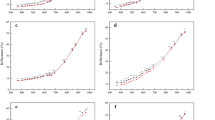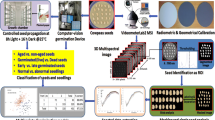Abstract
The tests commonly used to determine seed vigor are often laborious and time-consuming; thus, rapid methods are highly required for identifying high-vigor seeds among different batches. In this paper, we describe a novel approach able to distinguishing among batches of soybean seeds of different physiological quality based on their nutrient content measured by laser-induced breakdown spectroscopy (LIBS) assisted by multivariate analysis and machine learning algorithms. These include principal component analysis (PCA), support vector machine learning (SVM), linear and quadratic discriminant analyses (LDA and QDA), and nearest neighbor methods (KNN). A total of 92 measurements, 46 collected from batches marketed as low-vigor seeds and 46 as high-vigor seeds, were analyzed. The SVM method performed the best in discriminating among the batches. In particular, the quadratic SVM function could classify correctly 100% of the high-vigor samples and 97.8% of the low-vigor samples, whereas the cubic function yielded the opposite result; i.e., 97.8% of the high-vigor samples and 100% of the low-vigor samples were classified correctly. The best LIBS spectral region for the analysis was in the range of 350–450 nm, with calcium being the main distinguishing element. Thus, the LIBS technique combined with machine learning classification methods showed a promising potential for classifying soybean seed batches according to their physiological quality.





Similar content being viewed by others
References
Allegretta I, Marangoni B, Manzari P, Porfido C, Terzano R, Pascale O, Senesi GS (2020) Macro-classification of meteorites by portable energy dispersive X-ray fluorescence spectroscopy (pED-XRF), principal component analysis (PCA) and machine learning algorithms. Talanta 212:1–8
BRASIL (2009) Ministério da Agricultura, Pecuária e Abastecimento. Regras para análise de sementes. Ministério da Agricultura, Pecuária e Abastecimento. Secretaria de Defesa Agropecuária. Brasília, MAPA/ACS, p 395
Brazil: Oilseed and products update. USDA United State department of agriculture—foreign agricultural service. https://www.fas.usda.gov/data/brazil-oilseeds-and-products-update-22. Accessed 06 May 2020
Cremers DA, Radziemski LJ (2006) Handbook of laser-induced breakdown spectroscopy, 2nd edn. John Wiley & Sons, Chichester
Custódio CC (2005) Testes rápidos para avaliação do vigor de sementes: uma revisão. Colloquium Agrariae 1:29–41
El Haddad J, Canioni L, Bousquet B (2014) Good practices in LIBS analysis: review and advices. Spectrochim Acta - Part B 101:171–182
Filho JM (2015) Seed vigor testing: an overview of the past, present and future perspective. Sci Agric 72:363–374
França-Neto J, Krzyzanowski FC, Costa NPO (1999) O teste de tetrazólio em sementes de soja. Embrapa-CNPSo
Gredilla A, Vallejuelo SFO, Elejoste N, Diego A, Madariaga JM (2016) Non-destructive spectroscopy combined with chemometric as a tool for green chemical analysis of environmental samples: a review. TrAC Trends Anal Chem 76:30–39
Guerra MBB, Adame A, Almeida E, Carvalho GGA, Brasil MAS, Santos D Jr, Krug FJ (2015) Direct analysis of plant leaves by EDXRF and LIBS: microsampling strategies and cross-validation. J of Anal Atom Spect 30:1646–1654
Jolliffe IT (1973) Discarding variables in a principal component analysis. II: Real Data. J Royal Stat Soc 22:21–31
Liu YJ, Tran T, Postma G, Buydens LMC, Jansen J (2018) Estimating the number of components and detecting outliers using angle distribution of loading subspaces (ADLS) in PCA analysis. Anal Chim Acta 1020:17–29
Lussier F, Thibault V, Charron B, Wallace GQ, Masson JF (2020) Deep learning and artificial intelligence methods for Raman and surface-enhanced Raman scattering. TrAC Trends Anal Chem 124:1–44
Malavolta E, Vitti GC, Oliveira SA (1997) Avaliação do estado nutricional das plantas: princípios e aplicações. 2. ed. Piracicaba: Associação Brasileira de Potassa e do Fósforo, 319
Marangoni BS, Silva KSG, Nicolodelli G, Senesi GS, Cabral JS, Villas-Boas PR, Silva CS, Teixeira PC, Nogueira ARA, Benites VM, Milori DMBP (2016) Phosphorus quantification in fertilizers using laser-induced breakdown spectroscopy (LIBS): a methodology of analysis to correct physical matrix effects. Anal Meth 8:78–82
Marcos-Filho J (2013) Importância do potencial fisiológico da semente de soja. Informativo Abrates 23:21–24
Mazivila SJ, Olivieri AC (2018) Chemometrics coupled to vibrational spectroscopy and spectroscopic imaging for the analysis of solid-phase pharmaceutical products: a brief review on non-destructive analytical methods. TrAC Trends Anal Chem 108:74–87
Nicolodelli G, Cabral J, Menegatti CR, Marangoni B, Senesi GS (2019) Recent advances and future trends in LIBS applications to agricultural materials and their food derivatives: an overview of developments in the last decade (2010–2019). Part I. Soils and fertilizers. TrAC Trends Anal Chem 115:70–82
NIST Atomic spectra database lines form https://physics.nist.gov/PhysRefData/ASD/lines_form.html. Accessed 06 may 2020
Peng J, Liu F, Zhou F, Song K, Zhang C, Ye L, He Y (2016) Challenging applications for multi-element analysis by laser-induced breakdown spectroscopy in agriculture: a review. TrAC Trends Anal Chem 85:260–272
Pořízka P, Klus J, Képeš E, Prochazka D, Hahn DW, Kaiser J (2018) On the utilization of principal component analysis in laser-induced breakdown spectroscopy data analysis, a review. Spectrochim Acta - Part B 148:65–82
Ranulfi AC, Senesi GS, Caetano JB, Meyer MC, Magalhães AB, Villas-Boas PR, Milori DMBP (2018) Nutritional characterization of healthy and Aphelenchoides besseyi infected soybean leaves by laser-induced breakdown spectroscopy (LIBS). Microchem J 141:118–126
Romeis T, Ludwig AA, Martin R, Jones JDG (2001) Calcium-dependent protein kinases play na essential role in a plant defence response. EMBO J 15:5556–5567
Senesi GS, Romano R, Marangoni B, Nicolodelli G, Villas-Boas PR, Benites VM, Milori DMBP (2017) Laser-induced breakdown spectroscopy associated with multivariate analysis applied to discriminate fertilizers of different nature. J of App Spec 84:923–928
Senesi GS, Cabral J, Menegatti CR, Marangoni B, Nicolodelli G (2019) Recent advances and future trends in LIBS applications to agricultural materials and their food derivatives: an overview of developments in the last decade (2010–2019). Part II. Crop plants and their food derivatives. TrAC Trends Anal Chem 118:453–469
Tekrony DM, Egli DB (1991) Relationship of seed vigor to crop yield: a review. Crop Sci 31:816–822
Wen D, Hou H, Meng A, Meng J, Xie L, Zhang C (2018) Rapid evaluation of seed vigor by the absolute content of protein in seed within the same crop. Sci Rep 8:5569
Yun YH, Li HD, Deng BC, Cao DS (2019) An overview of variable selection methods in multivariate analysis of near-infrared spectra. TrAC Trends Anal Chem 113:102–115
Funding
This study was financed by Conselho Nacional de Desenvolvimento Científico e Tecnológico (CNPq), grant numbers 312376/2017-0, 4008127/2018-0, and 437867/2018-8. The authors also thank Coordenação de Aperfeiçoamento de Pessoal de Nível Superior—Brasil (CAPES)—Finance Code 001.
Author information
Authors and Affiliations
Corresponding author
Ethics declarations
Conflict of Interest
Gustavo S. Larios declares that he has no conflict of interest. Gustavo Nicolodelli declares that he has no conflict of interest.Giorgio S. Senesi declares that he has no conflict of interest. Matheus C.S. Ribeiro declares that he has no conflict of interest. Alfredo A.P. Xavier declares that he has no conflict of interest. Débora M.B.P. Milori declares that she has no conflict of interest. Charline Z. Alves declares that she has no conflict of interest. Bruno S. Marangoni declares that he has no conflict of interest. Cícero Cena declares that he has no conflict of interest.
Ethical Approval
This work does not contain any studies with human participants or animals performed by any of the authors.
Informed Consent
All authors have read the manuscript and agreed to submit it to the journal.
Additional information
Publisher’s Note
Springer Nature remains neutral with regard to jurisdictional claims in published maps and institutional affiliations.
Rights and permissions
About this article
Cite this article
Larios, G.S., Nicolodelli, G., Senesi, G.S. et al. Laser-Induced Breakdown Spectroscopy as a Powerful Tool for Distinguishing High- and Low-Vigor Soybean Seed Lots. Food Anal. Methods 13, 1691–1698 (2020). https://doi.org/10.1007/s12161-020-01790-8
Received:
Accepted:
Published:
Issue Date:
DOI: https://doi.org/10.1007/s12161-020-01790-8




